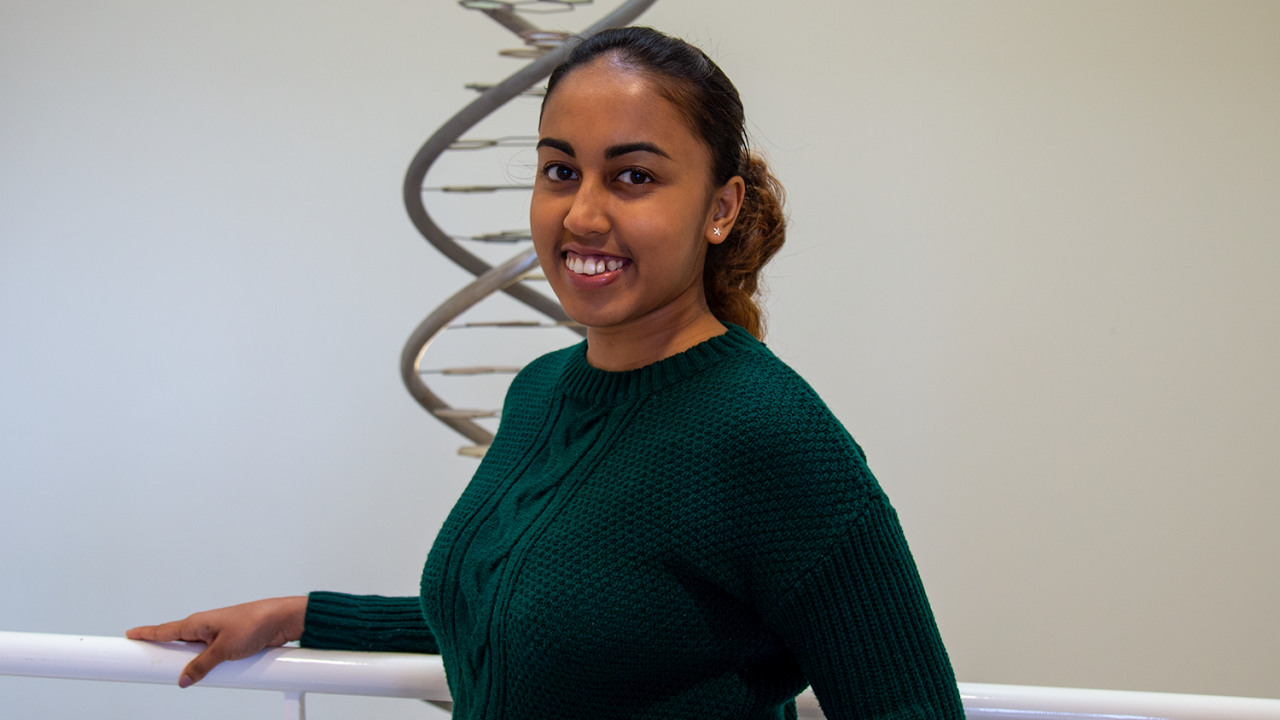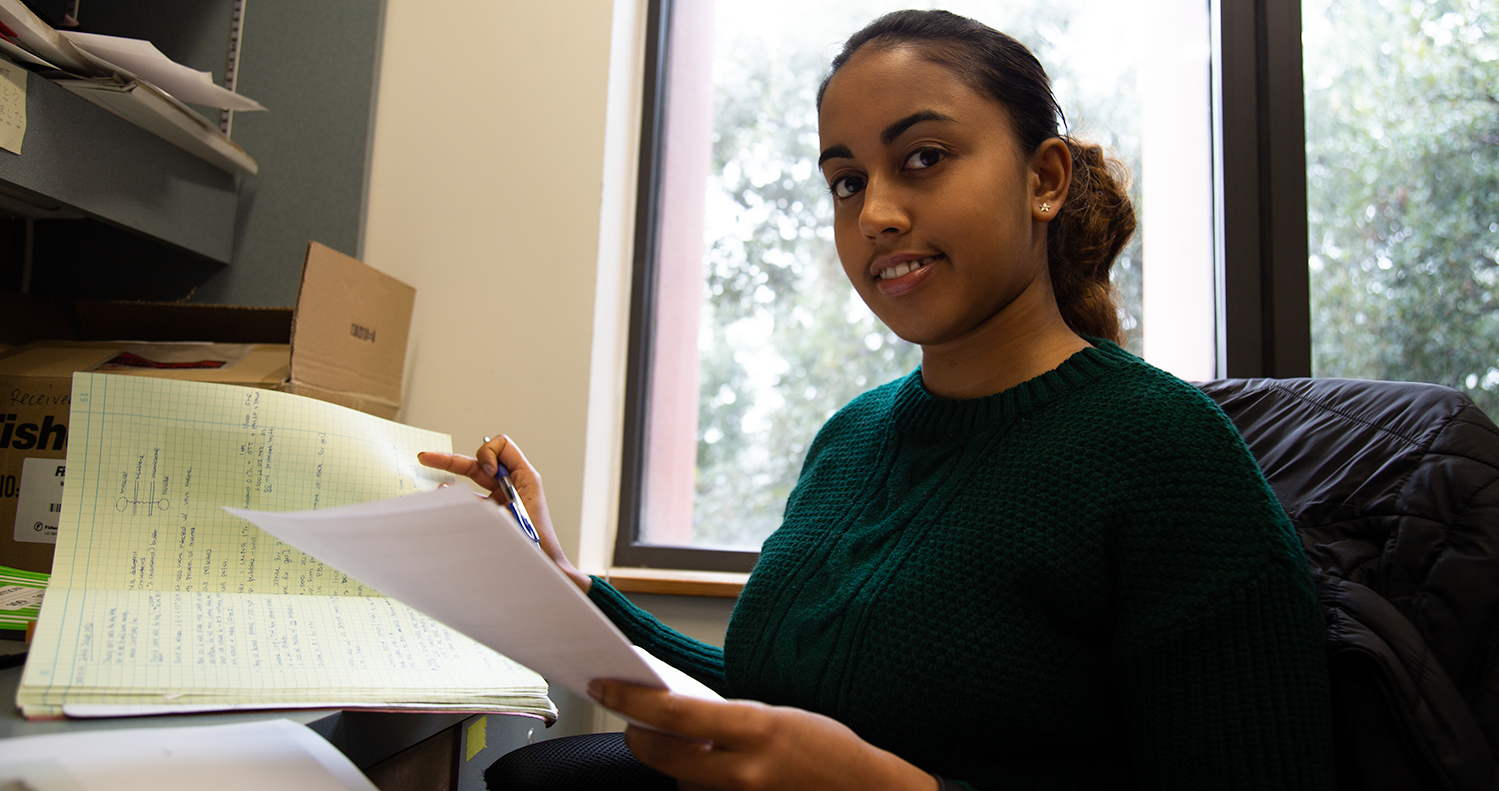
Taking a Bite Out of Research: BMCDB Ph.D. Student Natalie Sahabandu Reflects on Her Journey as an Aggie
Quick Summary
- Natalie Sahabandu is a Ph.D student in the BMCDB Graduate Group
- As an undergraduate at UC Davis, she participated in the Biology Undergraduate Scholars Program and was placed in the lab of Assistant Professor Katherine Ralston
- Sahabandu's interest in science and biology is all due to her mother, who carted the young Sahabandu to various science exhibitions at local universities in Sri Lanka
Natalie Sahabandu wasn’t sure how to properly hold a pipette when she joined Assistant Professor Katherine Ralston’s lab as an undergraduate researcher in June 2016. But all fledgling scientists start their research journeys somewhere.
“Being a minority and being a first-generation college student, it was super important to me to have a support system,” said Sahabandu, who enrolled in the Biology Undergraduate Scholars Program (BUSP) when she transferred to UC Davis in 2016. “I needed the best.”
With the help of Connie Champagne, director of Educational Enrichment and Outreach Programs, Sahabandu found her research footing in the Ralston Lab.
Interested in infectious diseases, Sahabandu investigated the finer points of cell nibbling, known formally as trogocytosis, for the remainder of her undergraduate career. Today, she’s a first-year Ph.D. student in the Biochemistry, Molecular, Cellular and Developmental Biology (BMCDB) Graduate Group and has won a handful of awards for her research. She’s even published her research and recently presented some of it at the 2019 joint meeting of the American Society for Cell Biology and the European Molecular Biology Organization.
Reflecting on the journey thus far, Sahabandu said, “One of the biggest highlights of my career has been the people who have been involved in this journey.”
And it all started with her parents.

New beginnings in a new country
Sahabandu's interest in science and biology is all due to her mother, who carted the young Sahabandu to various science exhibitions at local universities in Sri Lanka, including the University of Colombo and the University of Kelaniya. Sahabandu loved learning anatomy and initially thought the only potential career for a biologist was in medicine.
“A lot of people are trying to get into med school and there’s a lot of cultural pressure to go there if you’re good in sciences,” she said of Sri Lanka. “But early on, I knew that I loved sciences but maybe not medicine.”
“I remember seeing my first DNA gel in one of the exhibitions at the National Institute of Fundamental Studies in Sri Lanka, and my eyes lit up,” she continued. “I felt a connection there.”
Around the time Sahabandu finished her advanced levels, her family’s name was drawn from the Diversity Visa Lottery. With U.S. Visas and an awareness of the opportunity to expand their daughter’s horizons, Sahabandu’s parents decided to move to the United States of America.
“My parents made a huge sacrifice for me to be here as they were well established in Sri Lanka,” said Sahabandu.
The family moved to California and Sahabandu started exploring alternative career options in the science realm, including research. After completing courses at Ohlone College, a community college in Fremont, Calif., Sahabandu chose to apply to UC Davis specifically for its breadth of undergraduate research opportunities, but also because she was searching for a community, for a place to call home.

“I arrived as a Genetics and Genomics major and I wanted to do something that was related to genetics and genomics,” said Sahabandu. “Work done in Dr. Ralston’s lab was very interesting to me because she was looking at this amoeba that was nibbling on human cells.”
Reflecting on Sahabandu, Ralston said, “I was struck by Natalie’s enthusiasm for science and also how proactive she was in seeking out opportunities to gain research experience.”
Taking a bite out of research
After a crash course in lab basics, Sahabandu rolled up her sleeves and began her own projects in the Ralston Lab. Cell nibbling, or trogocytosis, occurs when the parasitic pathogen Entamoeba histolytica infects a human host. The pathogen literally kills human cells by nibbling on them piece by piece.
“Because Natalie came into my lab with a strong interest in genetics and genomics, her work in my lab focused on developing genetic tools to study proteins that we think might have roles in cell nibbling by E. histolytica,” said Ralston.
Sahabandu developed genetic tools to make mutants defective in potential genes involved in this process. She then used SNAP-tag technology to study the protein expression of these genes.
“By the time I left the lab, I successfully made SNAP-tag tools to study two genes of interest where we could look at the protein expression,” she said. “The lab is still working on some of these projects.”
Identifying the genes responsible for trogocytosis could help scientists create techniques to stop its progression.
Sahabandu also performed research outside of the Davis Campus. In summer 2017, she interned in Associate Professor Jeffrey Bush’s lab at the University of California, San Francisco, where she started studying birth defects that affect the hindgut.
“I was exploring the hindgut development of mouse embryos, where the rectum and the urethra are separating at a certain point,” said Sahabandu. “In certain cases they stay connected, which is what we call an urorectal fistula. I was interested in a particular signaling molecule that would be important for the separation to occur.”
The research experience helped familiarize Sahabandu with the tools of microscopy and 3-D modeling, skills that proved handy during her post-baccalaureate role at the National Cancer Institute in Frederick, Md.

From coast to coast
After graduation, Sahabandu put her developing microscopy skills to quick use at the National Cancer Institute. Advised by Jadranka Loncarek, the head of the Centrosome Biology Section, Sahabandu helped refine a technique called expansion microscopy.
Specifically, Sahabandu’s colleagues were interested in using this technique to better image centrioles, which are microtubule-based cylindrical structures that build centrosomes and cilia. Due to their small size (~230 x 400nm), centrioles are challenging to study.
“Expansion microscopy was a new hot topic in the microcopy field but its efficacy for isotropic expansion and routine analysis of centrioles and cilia was yet to be proven,” said Sahabandu. “We wanted to modify the protocol for robust, reliable and tunable expansion and detection of centrioles and cilia in mammalian cultured cells.”
Expansion microscopy physically enlarges the biological sample of interest, kind of like those grow-in-water-overnight toys.
Sahabandu spent the majority of her post-baccalaureate experience refining the technique, optimizing it for analyzing centrioles and cilia. A paper she wrote on the topic was published last November in the Journal of Microscopy. She presented the research at the 2019 joint meeting of the American Society for Cell Biology and the European Molecular Biology Organization.

Returning to the herd
Sahabandu returned to UC Davis for her graduate studies. As a first-year Ph.D. student, she’s rotated through a handful of labs, including the labs of Assistant Professors Priya Shah, Sean Collins and Richard McKenney.
“I’m so happy to see that Natalie has come full circle and returned to UC Davis for her graduate studies,” said Ralston. “I know we’re lucky to have her here.”
“I am excited to be part of the BMCDB graduate group,” said Sahabandu. “It is such a unique graduate group that provides a lot of support for the students to succeed in a holistic fashion. The program faculty, administrators and students are very helpful in both class and many other areas of cultivating future scientists. It feels good to be back as an Aggie, doing what I love in research, in a place I can call home.”

